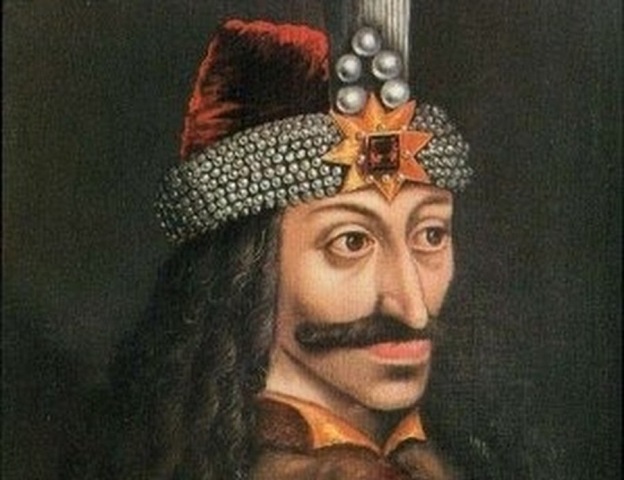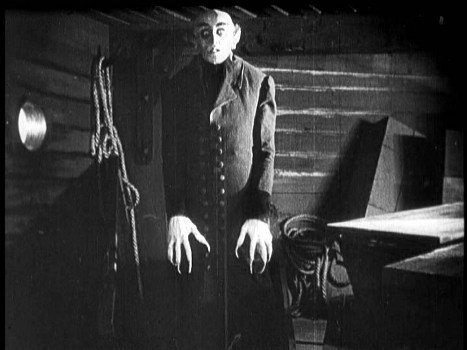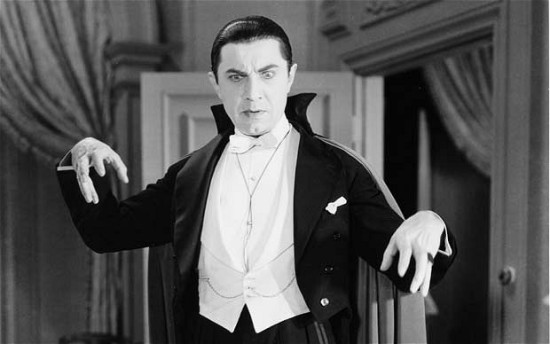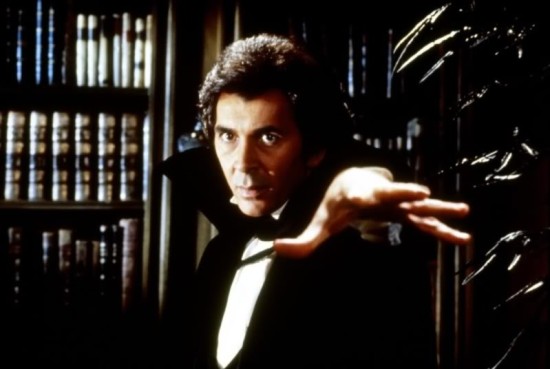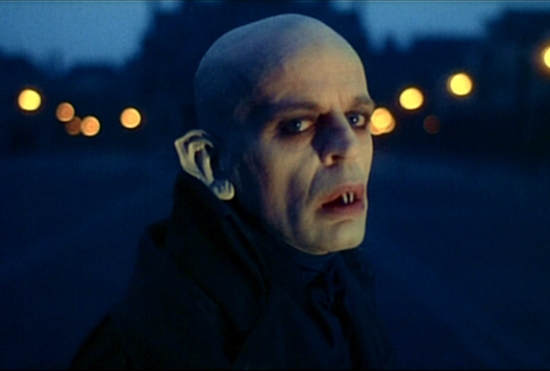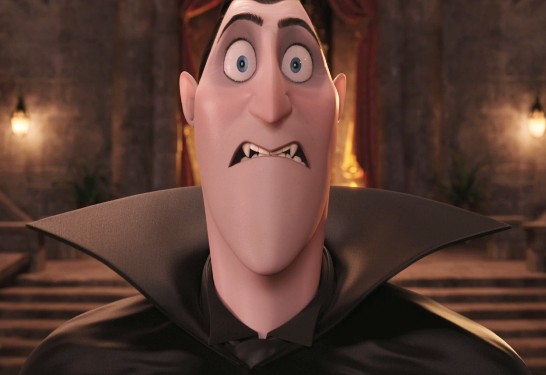Every year when the Halloween season comes around again, we start to spotlight and celebrate the iconic monsters that populate the traditions of the holiday. You’ve got your zombies, your demons, your Frankenstein monsters, and your warewolves. But the monster that is the most iconic of the bunch seems to be the vampire, which is currently seeing a resurgence (for better or worse) in pop culture. Thanks to stories like those in the Twilight series, younger audiences in particular are now looking at vampires as not only fascinating monsters, but also as desirable role models as well; which unfortunately is a sad reduction of the real menace and attraction that vampires have had in pop culture in the past. Vampires have made far better villains in the past than instead of being the superheros that they are in today’s young adult driven media. And no better vampire figure made menace and evil look so good on the big screen than the great Count himself, Dracula. Though Dracula is larger than life and among the most imaginative monsters around, he is actually based off of a real life historical figure. Vlad Tepes III, Prince of Wallachia, ruled his kingdom in modern day Romania in the late 15th century, becoming a valuable ally for christian Western Europe in repelling Turkish invaders. However, though he was a popular king in his time, history has instead focused more on the brutality he showed towards his enemies, much of which has defined the legend around him. Dubbed Vlad the Impaler, due to his common practice of impaling people on spikes outside his Transylvanian stronghold, the man’s legacy became one of blood-soaked terror. Legends soon sprang up around the man, including one’s where people believed that he drank the blood of his enemies.
Like most legends, these were exaggerated accounts, but over time they managed to catch the interest of a gothic Irish novelist named Bram Stoker, who distilled all of the legends of Vlad the Impaler and crafted them into his now legendary 1897 novel, Dracula. Taken from the name of Prince Vlad’s ancestral house name, Draculesti, Bram Stoker crafted what would eventually become the first true literary representation of a modern vampire. Though vampirism had been present in literature for centuries before, Stoker is the one who set much of rules and mythology behind the creatures. The idea of vampires being immortal and able to infect others once they are bitten came from Stoker’s novel, as well as the ideas that vampires rest during daylight in coffins and cannot cast a reflection in any mirror. Whether he planned it or not, Stoker’s novel would become the Bible to which all future depictions of vampires would follow, and over a century after the novel first premiered, it’s influence is still apparent in most if not all vampire stories today. And the reason for this is probably because the central monster of his story, Count Dracula, is such an iconic and unforgettable creature who can still send chills down the spines of audiences both young and old. As far as vampires go, there are none who are as frightening, or as seductive, or as commanding as the Count. And though his character has changed little overall since Stoker’s original novel, it is interesting to see how Dracula has been adapted and re-adapted again to connect with audiences over time, while still maintaining his most essential elements. In this article, I will be looking at some of the most notable cinematic iterations of the character, and see how well they have adapted and redefined the character over time.
MAX SCHRECK from NOSFERATU, A SYMPHONY OF TERROR (1922)
The first cinematic telling of the tale came from groundbreaking German expressionist director F.W. Murnau. Though Murnau sought to adapt the original novel for his movie, he was denied the rights by Bram Stoker’s estate, since they believed that the new cinema art-form was nothing but trash and unworthy of a story like Dracula. But Murnau was determined to get his vision of the story on the big screen and he worked through a loophole where he could make the same story as long as he changed the names of the characters and the location of the setting. Therefore, Count Dracula became Count Orlock and the setting moved from England to Bavaria. But make no mistake, it’s still the same story and Murnau proved exactly why the movie needed to be made in the first place. The film is remarkably creepy and Gothic, which was quite a feat to accomplish back in the early days of cinema. Murnau especially makes great use of the shadows to get the more horrific moments of the movie across in subtle ways. But, what really sells this film is the intensely creepy performance by Max Schreck as Count Orlock. His performance is so perfect here that it actually led to speculation at the time that the man was an honest to goodness real vampire; something that provided the inspiration for the movie Shadow of the Vampire (2000), starring Wilem Dafoe as Schreck. I especially love the whole vampire bat motif that the character embodies, which makes him a truly grotesque movie monster. Though there were objections to the portrayal of Dracula on the big screen beforehand, there were none after seeing the brilliant results in Nosferatu.
BELA LUGOSI from DRACULA (1931)
Although Murnau’s take on the character may have set a foothold in cinematic history, it was Hollywood that truly made Count Dracula an icon. Directed by Hollywood shockmaster Tod Browning (Freaks), 1931’s Dracula brought Stoker’s famous character to life better than anyone could have expected, and that is largely thanks to the absolutely perfect casting of Bela Lugosi as the Count. Lugosi has probably had more influence in defining the character of Dracula than anyone else, other than Bram Stoker of course. His ability to deliver such menace in his eyes and the simple gesturing of his claw-like fingers brings so much out of the character and it helps to sell the idea of the true horror that this vampire inflicts without ever having to show it. Bela’s appearance would also influence the character, with his floor length cape and slicked back hair. But it was his voice that would have the most impact overall. The movie was made in the early days of recorded sound in movies, and no one had any idea what Dracula would sound like, so it seemed natural that Bela’s deep Hungarian accent would stand out in the film; giving the character an almost melodic and seductive tone to his voice, which fit perfectly for the character. Every depiction of Dracula since has taken some inspiration from Lugosi’s version, whether it’s the accent or the costume, which shows just how iconic his performance is. Unfortunately, it was a character he never was able to grow out of, and his latter career found the man typecast in cheaper knockoffs of the original tale. Still, his performance in the original is beloved today and has made Bela Lugosi a fan favorite to people all over the world.
CHRISTOPHER LEE from HAMMER PICTURES’ DRACULA SERIES (1958-1973)
While Bela Lugosi’s take on Count Dracula may be the most iconic, famed British actor Christopher Lee’s version would become the most prolific. Lee portrayed the Count in nine different movies over a 15 year period, as well as portraying vampires in many other films as well, helping to cement his reputation as the go-to-guy for vampire movies for a long time. Made by the England-based Hammer film company mostly during the mid to late 60’s, these Dracula movies were more stylized and graphic than the previous Hollywood versions of the story. Where Hollywood would imply the horror offscreen, Hammer would display it in all it’s bloody glory. Indeed, Hammer Films brought out more of the monster in the character of Dracula and helped to cement him as one of cinemas most truly horrifying creatures. That’s not to say that he was completely savage either. Hammer was wise enough to cast a quality actor like Christopher Lee in the role, who manages to balance the refined and seductive elements of the character with the more horrific. He really captures the humanity of the character well in the movies, but is also not afraid to indulge in the animalistic terror that the Count also possesses. One of the best touches that they added to the character in these films was the way that Dracula’s eye burn red whenever he’s ready to feast on his victim. It’s a remarkably terrifying take on the character, and this role no doubt helped to shape Lee’s reputation as a memorable heavy in horror movies; something he would bring with him in later roles like Saruman in the Lord of the Rings movies and Count Dooku in Star Wars. Not only that, but he also managed to give the character the update that he needed in a less innocent time, while still staying true to the character’s roots.
FRANK LANGELLA from DRACULA (1979)
After the gorier versions of Dracula made by the Hammer films, this version directed by John Badham tried to bring the character back to his more Gothic, Victorian roots. The results were well crafted, if a bit stale. By no means a bad retelling of the original tale, this one still feels a little lacking mainly because it departs so much from what had made the character so popular over the last few decades. Instead, this version of Bram Stoker’s tale wants to tell the Masterpiece Theater version of the story, with lush production values and refined, theatrical dialogue. That’s not to say that they water down the character at all, and indeed the best element of the movie is still it’s central monster. Frank Langella definitely plays up more of the seductive side of Dracula’s character, making him both charming and alluring. But, when he does go into full vampire mode, he does manage to come off creepy and menacing. A break-in scene where he hangs upside down like a bat outside of his victim’s window is an especially frightening moment, and he manages to pull off the dead eye stare very well in that moment. Unfortunately, the movie is also dialogue heavy in the wrong places, and it would have served the character better to have had a lot more moments play out silently like that creepy break-in scene did. Interestingly, this is one of the more youthful depictions of the character, showing Dracula as less of the lecherous older man that he had been in previous versions, and more like a dashing young bachelor who can more convincingly seduce his female victims, which Langella embodies very well here. It’s a flawed retelling, but one where the character still shines through.
KLAUS KINSKI from NOSFERATU THE VAMPYRE (1979)
Departing from the Hollywood image of the Count that had become more or less standardized over the years, German director Werner Herzog decided to take the character of Dracula all the way back to his cinematic beginnings and undertake a remake of F.W. Murnau’s Nosferatu. While many people would scoff at the idea of wanting to remake a beloved classic like Nosferatu, it actually seems like the perfect project for an unpredictable and button-pushing director like Herzog. Add to the mix a performance by the equally experimental and temperamental German actor Klaus Kinski as the titular vampire and you’ve got a remake that is worth seeing. The end results are mixed; amazingly the movie is only half as scary as the original, which is not good given all the advancements in cinema since the original was made. And I think that’s largely due to Herzog’s inability to make this movie stand out against it’s predecessor. You can sense the director’s affection for the original, but by emulating it so much, his film lacks any identity in itself. However, where the movie does excel is in Kinski’s performance as Count Orlock. While not as creepy as Max Schreck’s version, it is still nevertheless a bizarre and engaging performance that’s well suited for the character, as well as for the notoriously oddball actor. He embodies the character perfectly, and even manages to find some depth in the performance that wasn’t there originally in Schreck’s portrayal. As far as remakes go, the movie could have done a lot worse, and it does still works for the most part by staying true to the depiction of it’s central vampire. Still, if you had to choose between the two, I would still recommend the original, and only check out this version for Kinski’s performance.
GARY OLDMAN from BRAM STOKER’S DRACULA (1992)
Lugosi may have set the standard for the character, and Christopher Lee may have given the character his frightening backbone, but if I were to pick the greatest single portrayal of the character of Count Dracula, it would be this remarkable performance by Gary Oldman. Oldman truly proves why he is one of the greatest actors of our time with this multi-layered, nuanced, and just downright terrifying portrayal of Dracula in the movie directed by Francis Ford Coppola. In many ways, his performance is an amalgam of all the previous versions of the character all put into one. His early scenes as the incredibly creepy, ashen-faced vampire contains echos of Lugosi and Lee’s versions within it, played out in a wonderfully over-the-top fashion that’s all Oldman’s own. And then when the movie shifts to it’s London-based second half, we see Oldman embody the seductive, youthful version of the character that Frank Langella first brought to the screen. And Gary Oldman manages to infuse all of these elements together perfectly in a remarkably soulful performance. This is a Dracula that brings in all the familiar elements, but is brought to life in a way that we’ve never seen before, making this version feel wholly unique. If only the movie surrounding the performance was better. While not terrible by any means, Coppola’s movie does feel disjointed at times, especially when Dracula is not front and center. It’s also a really bizarre movie too, with many scenes taken to such outlandish extremes, that it sometime feels exploitative (not to mention that it features Keanu Reeves embarrassingly trying to work a British accent into his performance). Still, Gary Oldman is the absolute highlight of the movie, and elevates the piece as a whole. It’s probably well suited that the movie is a little on the messy side, because it makes his groundbreaking work in the role stand out all the more.
ADAM SANDLER from HOTEL TRANSYLVANIA (2012)
Certainly an odd pick to include with all the others in this article, but I chose to highlight this version of the character because it illustrates the impact that the character has had in pop culture and on Gothic horror tropes in general. This animated film focuses on a luxury resort run by monsters for monsters, with Dracula himself is the owner and caretaker. Naturally, there are in-jokes to be had regarding the monstrous inhabitants of the titular hotel, and the filmmakers actually show off a particularly extensive knowledge of all the different monsters that they are spoofing. Like many people have said, spoofing is the highest forms of flattery, and that’s exactly what goes on in Hotel Transylvania. While nowhere near Disney/Pixar in quality, this film is surprisingly better than it has any right to be, especially considering that it features Adam Sandler in the role of Dracula. The reason for this is because of the quality of it’s humor. Hotel Transylvania does an effective job of taking many notable elements of Dracula’s persona and turning them on it’s head. And indeed there are clever nods to past versions of the character, like Sandler laying on the thick accent that Lugosi made popular, or the glowing red eyes that Christopher Lee had introduced. It all brings together a version of the character that can exist within a PG-rated cartoon, without feeling like an insult to previous versions. Indeed, this movie does a better job of poking fun at Dracula movies than what Mel Brooks failed to do with his Dracula, Dead and Loving it (1995); a rare misfire for the usually reliable humorist. Is Hotel Transylvania a great movie? No, but it serves as a fine introduction to the character for younger audiences.
Dracula has had a long history as an icon for both cinematic and literary horror, and his legacy shows no signs of stopping. Even this very week we are getting a new film called Dracula Untold (2014) which gives the vampire the Game of Thrones treatment by drawing upon more of the historical figure of Vlad the Impaler and infusing him with all of the famous tropes of the modern Dracula character. What is interesting about the character today, however, is that he’s managed to become not just a defining character within his own story, but pretty much the symbol of the Halloween season itself. Dracula has managed to outshine all other Halloween monsters to become the leader of the pack, and is usually depicted as such in many Halloween themed films; particularly the ones aimed at kids. The fact that Dracula has become an accepted movie monster in kids entertainment just shows you how far flung his influence has been. And the reason why Dracula has had such a deep impact in our pop culture is because of the many great cinematic incarnations he’s had. From the creepy re-imagining of Nosferatu to the iconic portrayals by Lugosi, Lee, and Oldman, he’s a character that has deservedly “staked” his claim in our collective imaginations. And what makes him so interesting is the fact that he embodies all the things that we fear the most; the danger of the unknown and loss of innocence. No one else embodies the idea of vampirism better than the Count and one wishes that his creepy, seductive presence would take a hold once again over all of these recent cinematic vampire wannabes. You know why true horror fans always gravitate towards Count Dracula in the end? Because Dracula doesn’t sparkle.
